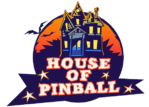Pinball is more than just a game—it’s a cultural icon that has evolved dramatically over the past century. Whether you’re a seasoned collector or a newcomer looking to buy a pinball machine for sale, understanding the history of pinball can help you make an informed choice and appreciate the value behind every machine.
At House of Pinball, we pride ourselves on guiding enthusiasts in Italy and beyond to find the perfect flipper that suits their style and space. Today, we’ll take you on a visual journey through the evolution of pinball—from its early beginnings as Bagatelle tables to the high-tech LCD screens of modern machines.
1. The Origins: Bagatelle (Late 1800s)
The story begins with Bagatelle, a popular tabletop game from the late 19th century, often considered the ancestor of modern pinball. Bagatelle featured a small inclined board with pins and holes; players used a cue stick to shoot balls, aiming to land in high-scoring pockets.
Why it matters: Bagatelle set the stage for the core mechanics of pinball—precision, luck, and scoring zones.
2. The Birth of Coin-Operated Pinball (1930s-1940s)
The early 20th century saw the introduction of coin-operated pinball machines, allowing players to enjoy the game in arcades and bars. These machines were purely mechanical, lacking flippers, and relied on gravity and nudging.
Visual highlights:
- Simple wooden cabinets
- Steel balls and bumpers
- Glass covers protecting the playfield
Collector tip: Original machines from this era are rare and highly prized, but often delicate and less interactive than later models.

3. The Flipper Revolution (1947)
Pinball took a giant leap forward in 1947 when flippers were introduced by Gottlieb’s “Humpty Dumpty” machine. This innovation changed the game from pure chance to a skill-based challenge, allowing players to control the ball’s movement.
Key changes:
- Two to six flippers strategically placed on the playfield
- Increased game complexity and replay value
- Emergence of themed artwork on cabinets
Advice: Machines with flippers are the best entry point for players wanting skillful gameplay and nostalgia combined.
4. The Electromechanical Era (1950s-1970s)
This era introduced electromechanical components like score reels, bumpers, and more advanced sound effects, which elevated gameplay and interactivity.
Features:
- Flashing lights and sound chimes
- More complex scoring rules
- Classic themed artwork reflecting pop culture
Many collectors love this era for its blend of mechanical charm and evolving technology.
5. The Digital Revolution: Solid-State Pinball (1977-1990s)
The transition to solid-state electronics transformed pinball machines dramatically. Digital score displays replaced mechanical reels, and soundtracks became richer with synthesized music and speech.
Benefits:
- LCD score displays replacing mechanical counters
- Multiball modes and mini-games
- Enhanced artwork and themes based on movies, comics, and TV shows
Buying insight: Solid-state machines offer a great mix of vintage appeal and modern reliability, often with extensive support and parts availability.
6. The Modern Era: Dot Matrix and LCD Screens (1990s-Present)
Modern pinball machines incorporate dot matrix displays (DMDs) and now, increasingly, full-color LCD screens. These technologies provide stunning animations, interactive storylines, and dynamic gameplay.
Highlights:
- High-definition animations and video modes
- Integrated audio-visual storytelling
- Customizable settings and online connectivity in some models
Manufacturers like Stern and Jersey Jack lead the way with premium machines that combine nostalgic gameplay with cutting-edge technology.
Why Understanding Pinball History Helps You Buy Better
Knowing the history of pinball machines helps you decide what fits your preferences:
- Collector? Consider rare electromechanical or early flipper machines.
- Player? Look for solid-state or modern LCD pinballs for gameplay depth.
- Budget-conscious? Classic mechanical machines can be affordable and charming.
- Tech enthusiast? Newer models with LCD screens offer immersive experiences.
At House of Pinball, we offer a curated selection spanning all eras, ensuring you find the perfect match.
Ready to Buy Your Pinball Machine?
If you’re searching for the best pinball machine for sale in Italy, trust House of Pinball for expert advice, genuine products, and after-sales support. Whether it’s a nostalgic vintage piece or a brand-new LCD-enhanced model, we help you bring the magic of pinball into your home.
Contact us today to explore our inventory or request a personalized consultation!

